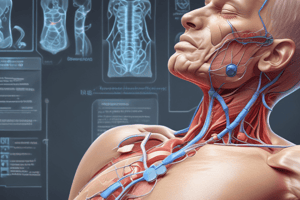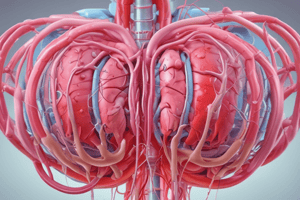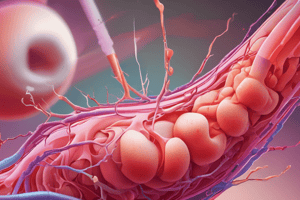Podcast
Questions and Answers
What is the purpose of performing thoracentesis in some cases?
What is the purpose of performing thoracentesis in some cases?
To introduce chemotherapeutic drugs intrapleurally.
Why are arterial blood gases (ABGs) preferred over venous blood for evaluating a client's gas exchange in the pulmonary system?
Why are arterial blood gases (ABGs) preferred over venous blood for evaluating a client's gas exchange in the pulmonary system?
Arterial blood provides a more accurate reflection of gas exchange.
What is the importance of applying pressure to the puncture site after drawing blood from a high-pressure artery?
What is the importance of applying pressure to the puncture site after drawing blood from a high-pressure artery?
To reduce the risk of bleeding or bruising.
How does an electrocardiogram (ECG) provide information about the heart's electrical activity?
How does an electrocardiogram (ECG) provide information about the heart's electrical activity?
What is the purpose of an echocardiogram in evaluating cardiac function?
What is the purpose of an echocardiogram in evaluating cardiac function?
What is the purpose of performing bronchoscopy?
What is the purpose of performing bronchoscopy?
Why is obtaining sputum and throat culture specimens important in respiratory assessment?
Why is obtaining sputum and throat culture specimens important in respiratory assessment?
How do arterial blood gases help evaluate a client's gas exchange in the pulmonary system?
How do arterial blood gases help evaluate a client's gas exchange in the pulmonary system?
What is the significance of pulmonary function tests?
What is the significance of pulmonary function tests?
Why are x-rays and lung scans commonly used in respiratory diagnostics?
Why are x-rays and lung scans commonly used in respiratory diagnostics?
What is the primary purpose of performing a sputum culture?
What is the primary purpose of performing a sputum culture?
What specific respiratory function is assessed by measuring arterial blood gases?
What specific respiratory function is assessed by measuring arterial blood gases?
Describe the primary function of pulmonary function tests.
Describe the primary function of pulmonary function tests.
In the context of respiratory assessment, what is the significance of an enlarged heart observed on a chest X-ray?
In the context of respiratory assessment, what is the significance of an enlarged heart observed on a chest X-ray?
What is the primary purpose of performing a bronchoscopy in the context of respiratory assessment?
What is the primary purpose of performing a bronchoscopy in the context of respiratory assessment?
Explain the significance of obtaining sputum and throat culture specimens in diagnosing respiratory infections.
Explain the significance of obtaining sputum and throat culture specimens in diagnosing respiratory infections.
Describe the process and significance of analyzing arterial blood gases (ABGs) in evaluating respiratory function.
Describe the process and significance of analyzing arterial blood gases (ABGs) in evaluating respiratory function.
Discuss the role of pulmonary function tests in assessing lung function and diagnosing respiratory disorders.
Discuss the role of pulmonary function tests in assessing lung function and diagnosing respiratory disorders.
Compare and contrast the diagnostic capabilities of x-rays and lung scans in detecting lung abnormalities.
Compare and contrast the diagnostic capabilities of x-rays and lung scans in detecting lung abnormalities.
Explain the purpose and procedure of a bronchoscopy in diagnosing respiratory conditions.
Explain the purpose and procedure of a bronchoscopy in diagnosing respiratory conditions.
Explain the purpose and technique of pursed-lip breathing for promoting oxygenation.
Explain the purpose and technique of pursed-lip breathing for promoting oxygenation.
How does the use of an incentive spirometer assist with oxygenation and what are the steps to use it correctly?
How does the use of an incentive spirometer assist with oxygenation and what are the steps to use it correctly?
Explain the role of bronchodilators in promoting oxygenation and their preferred route of administration.
Explain the role of bronchodilators in promoting oxygenation and their preferred route of administration.
What diagnostic tests are commonly used to evaluate respiratory function and oxygenation status? Provide examples.
What diagnostic tests are commonly used to evaluate respiratory function and oxygenation status? Provide examples.
How do anti-inflammatory medications promote improved oxygenation and what routes can they be administered by?
How do anti-inflammatory medications promote improved oxygenation and what routes can they be administered by?
What are the important assessments and comfort measures to implement when a client is receiving oxygen via a nasal cannula?
What are the important assessments and comfort measures to implement when a client is receiving oxygen via a nasal cannula?
Why is obtaining sputum and throat culture specimens important in respiratory assessment?
Why is obtaining sputum and throat culture specimens important in respiratory assessment?
How do arterial blood gases help evaluate a client's gas exchange in the pulmonary system?
How do arterial blood gases help evaluate a client's gas exchange in the pulmonary system?
Why are x-rays and lung scans commonly used in respiratory diagnostics?
Why are x-rays and lung scans commonly used in respiratory diagnostics?
What is the purpose of performing bronchoscopy?
What is the purpose of performing bronchoscopy?
Explain the importance of obtaining a sputum culture specimen when evaluating respiratory conditions and the proper technique for collecting it.
Explain the importance of obtaining a sputum culture specimen when evaluating respiratory conditions and the proper technique for collecting it.
What are the key parameters measured in an arterial blood gas (ABG) analysis, and how do they provide insight into respiratory function?
What are the key parameters measured in an arterial blood gas (ABG) analysis, and how do they provide insight into respiratory function?
Describe the purpose and basic procedure of pulmonary function tests (PFTs) such as spirometry in evaluating respiratory disorders.
Describe the purpose and basic procedure of pulmonary function tests (PFTs) such as spirometry in evaluating respiratory disorders.
Explain the role of chest X-rays and advanced lung imaging techniques like CT scans in the diagnosis and monitoring of respiratory conditions.
Explain the role of chest X-rays and advanced lung imaging techniques like CT scans in the diagnosis and monitoring of respiratory conditions.
What is the purpose of performing a bronchoscopy, and what information can be obtained from this invasive procedure?
What is the purpose of performing a bronchoscopy, and what information can be obtained from this invasive procedure?
Flashcards are hidden until you start studying




